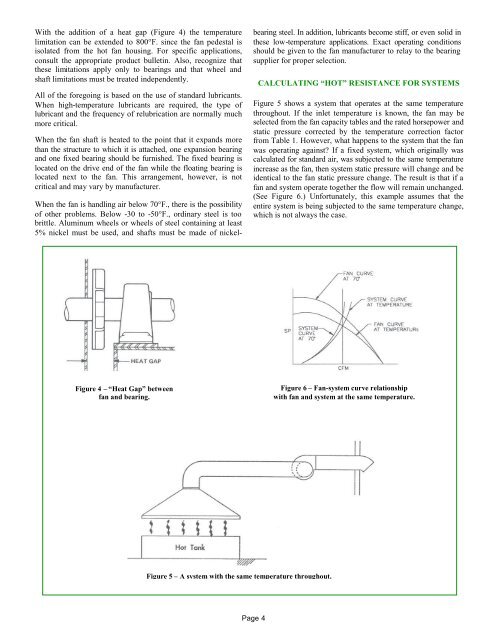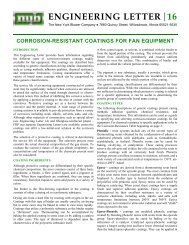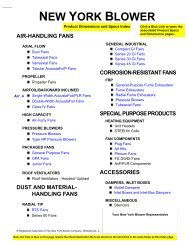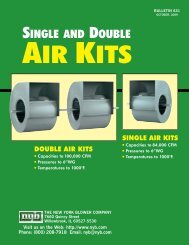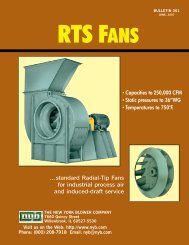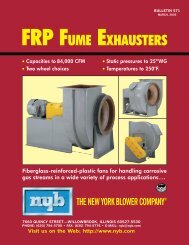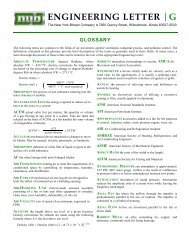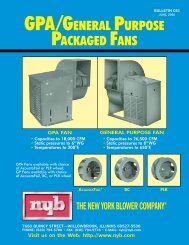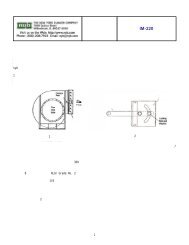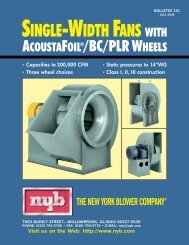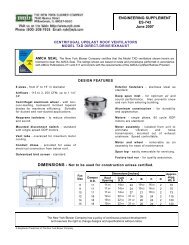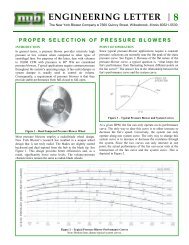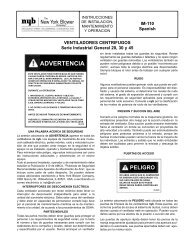Temperature and Altitude Affect Fan Selection - New York Blower
Temperature and Altitude Affect Fan Selection - New York Blower
Temperature and Altitude Affect Fan Selection - New York Blower
Create successful ePaper yourself
Turn your PDF publications into a flip-book with our unique Google optimized e-Paper software.
With the addition of a heat gap (Figure 4) the temperaturelimitation can be extended to 800°F. since the fan pedestal isisolated from the hot fan housing. For specific applications,consult the appropriate product bulletin. Also, recognize thatthese limitations apply only to bearings <strong>and</strong> that wheel <strong>and</strong>shaft limitations must be treated independently.All of the foregoing is based on the use of st<strong>and</strong>ard lubricants.When high-temperature lubricants are required, the type oflubricant <strong>and</strong> the frequency of relubrication are normally muchmore critical.When the fan shaft is heated to the point that it exp<strong>and</strong>s morethan the structure to which it is attached, one expansion bearing<strong>and</strong> one fixed bearing should be furnished. The fixed bearing islocated on the drive end of the fan while the floating bearing islocated next to the fan. This arrangement, however, is notcritical <strong>and</strong> may vary by manufacturer.When the fan is h<strong>and</strong>ling air below 70°F., there is the possibilityof other problems. Below -30 to -50°F., ordinary steel is toobrittle. Aluminum wheels or wheels of steel containing at least5% nickel must be used, <strong>and</strong> shafts must be made of nickelbearingsteel. In addition, lubricants become stiff, or even solid inthese low-temperature applications. Exact operating conditionsshould be given to the fan manufacturer to relay to the bearingsupplier for proper selection.CALCULATING “HOT” RESISTANCE FOR SYSTEMSFigure 5 shows a system that operates at the same temperaturethroughout. If the inlet temperature is known, the fan may beselected from the fan capacity tables <strong>and</strong> the rated horsepower <strong>and</strong>static pressure corrected by the temperature correction factorfrom Table 1. However, what happens to the system that the fanwas operating against? If a fixed system, which originally wascalculated for st<strong>and</strong>ard air, was subjected to the same temperatureincrease as the fan, then system static pressure will change <strong>and</strong> beidentical to the fan static pressure change. The result is that if afan <strong>and</strong> system operate together the flow will remain unchanged.(See Figure 6.) Unfortunately, this example assumes that theentire system is being subjected to the same temperature change,which is not always the case.Figure Figure 4 – 4 “Heat – “Heat Gap” Gap” betweenfan <strong>and</strong>fan <strong>and</strong> bearing.Figure 6 – <strong>Fan</strong>-system curve relationshipwith fan <strong>and</strong> system at the same temperature.Figure 5 – A system with the same temperature throughout.Page 4


